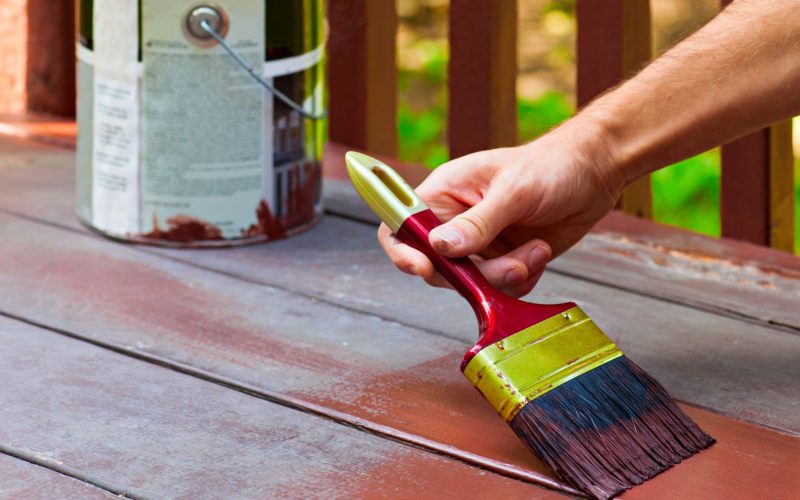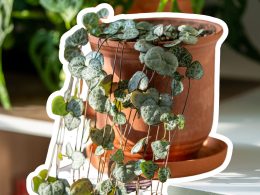Caring for houseplants can be tricky, especially when dealing with a less common species like the Pilea peperomioides, also known as the Chinese money plant.
Many plant lovers struggle to keep this unique plant thriving and wonder how to grow their collection.
I’m here to help you become a Pilea pro. In this guide, I’ll show you how to care for your Chinese money plant and multiply your collection through easy propagation.
We’ll cover everything from light and water needs to soil preferences and fertilization tips.
Plus, I’ll walk you through two simple ways to propagate your Pilea so you can share the joy with friends or expand your indoor garden.
What You’ll Need to Propagate Pilea Peperomioides

To properly care for and propagate your Chinese money plant, you’ll want to have these items on hand:
1. Equipment / Tools
- Sharp Knife: This will be handy for taking cuttings when ready to propagate your plant. Make sure it’s clean to avoid introducing any harmful bacteria.
2. Materials
- Well-Draining Soil: It is the key to keeping your Pilea healthy. Look for a mix of indoor plants that allows water to flow easily.
- Pots: You’ll need these for your main plant and any new ones you propagate. Make sure they have drainage holes at the bottom.
- Glass Containers: These are useful for water propagation. Clear containers let you easily see when roots start to form.
- Water: Of course, you’ll need this for both watering your plant and for water propagation methods.
These items will make it much easier to care for your Pilea peperomioides and grow new plants when ready. Remember, clean tools and containers are important to keep your plants healthy.
How to Propagate Pilea Peperomioides (Chinese Money Plant): 2 Ways
1. By Division Method
Dividing your Pilea peperomioides is a great way to make new plants, especially if your plant is older and has little plants (called offshoots) growing from its base.
This method works well because you’re using baby plants that have already started to grow naturally.
When you use this method, you have a good chance of success. The new plants often grow quickly and become strong because they already have little root systems.
Step 1: Take the Plant Out of Its Pot
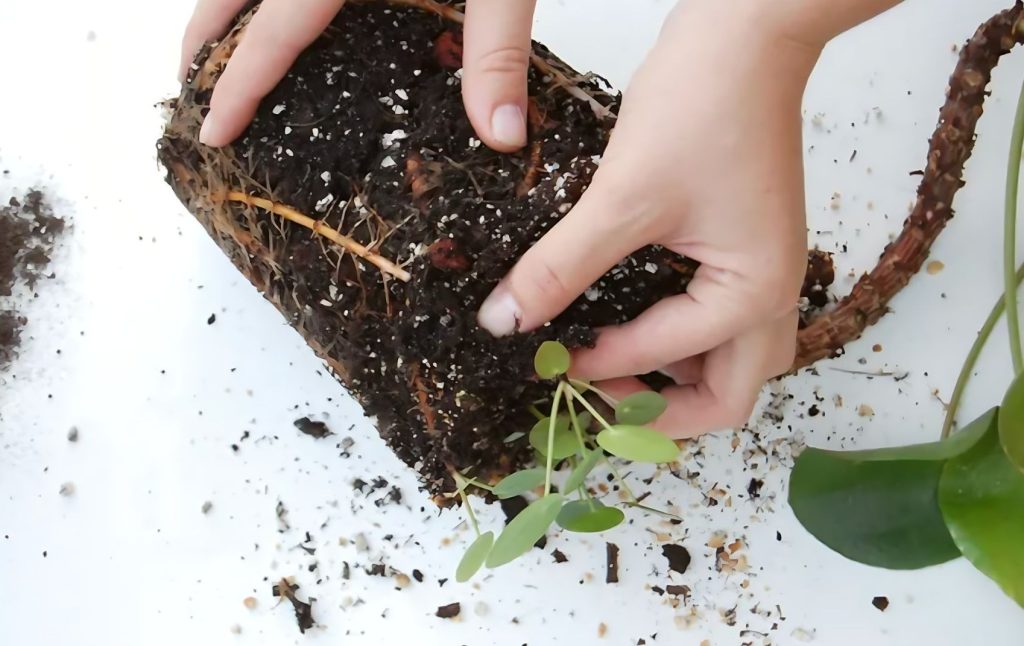
First, you need to get your plant out of its pot. Do this carefully to avoid hurting the plant. Here’s how:
- Tip the pot sideways and gently slide the plant out.
- If the plant doesn’t come out easily, you can loosen the soil around the edges of the pot.
- When you handle the plant, hold it near the bottom where the stems meet the soil. This helps prevent damage to the leaves and stems.
Step 2: Separating the Baby Plants
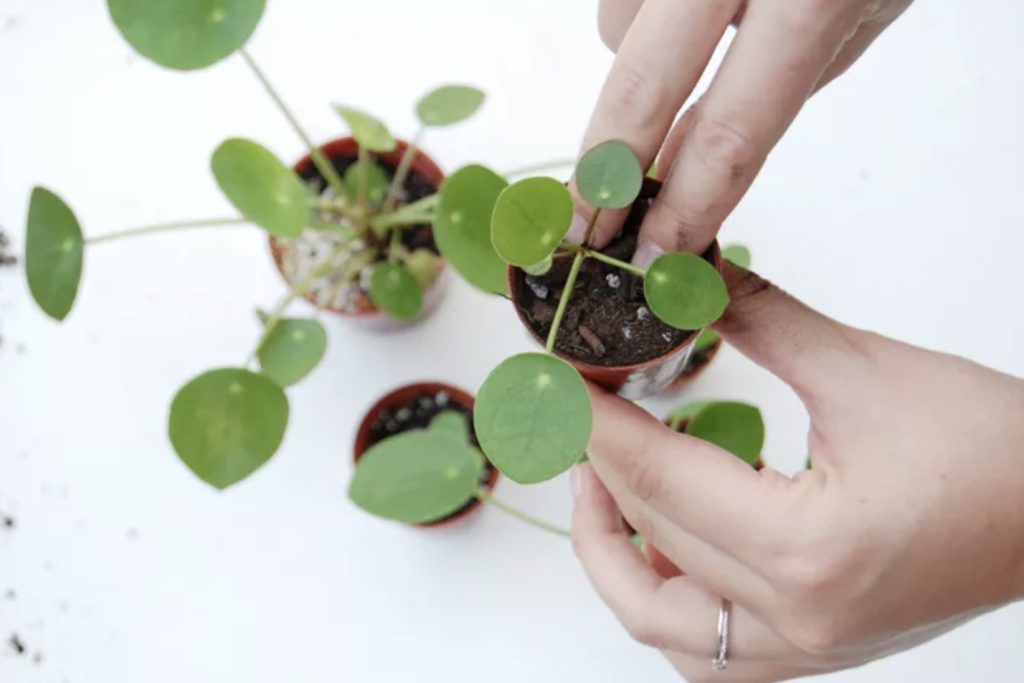
You can see the offshoots now that your plant is out of the pot. Here’s what to do:
- Look for the small plants growing from the base of the main plant.
- Gently pull these baby plants away from the mother plant. Thick roots connect them.
- Keep as many of the baby plant’s roots as possible. Use clean scissors or a sharp knife to cut any stubborn roots if necessary.
Step 3: Planting in New Pots

Now it’s time to give your new plants their own homes:
- Get some small pots ready. Make sure they have holes in the bottom for drainage.
- Fill each pot with soil that drains well.
- Make a small hole in the soil and place each baby plant in its pot.
- Pat the soil gently around the roots to help the plant stand up straight.
- Water each new plant well.
- Put your new plants in a spot with bright light but not direct sunlight.
By following these steps, you can turn one Pilea into several. It’s fun to grow your plant collection or share plants with friends.
2. By Leaf Cuttings Method
If your Pilea peperomioides (Chinese money plant) is still young and hasn’t grown any baby plants, you can use leaf cuttings to make new plants.
This method works well when you can’t use the division method we talked about earlier.
While this method isn’t as sure as dividing the plant, it can be successful if careful. It’s a great way to get the most out of a single plant, especially if you only have one.
Let’s go through the steps to make new Chinese money plants from leaf cuttings:
Step 1: Take a Leaf Cutting
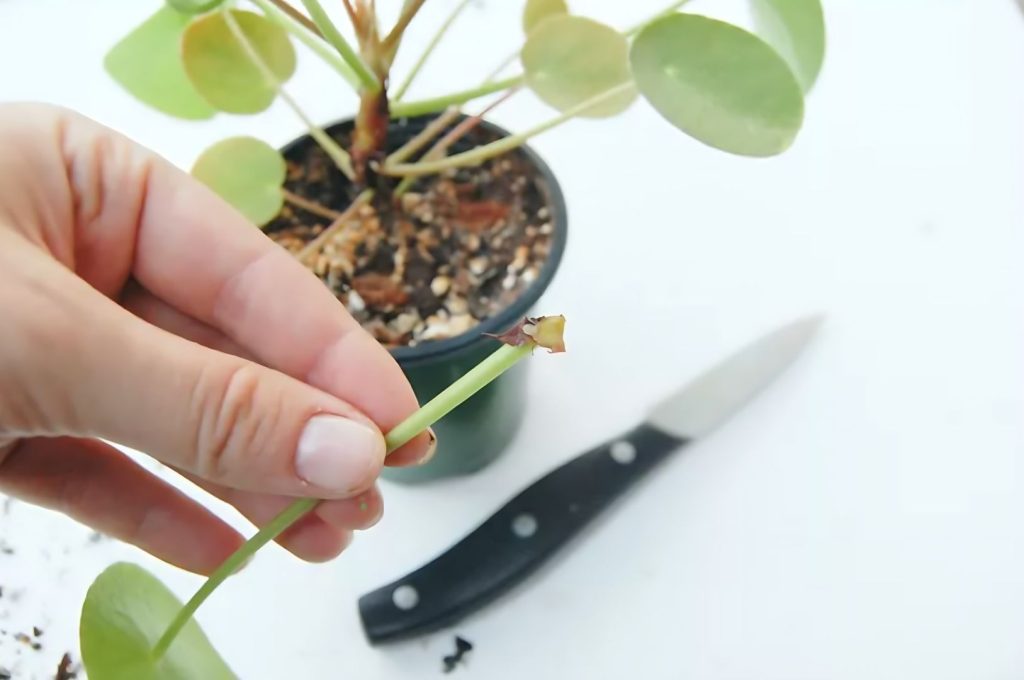
Here’s how to take a cutting from your plant:
- Choose a healthy, full-grown leaf from your Pilea.
- Use a sharp knife (not one with a jagged edge) to cut the leaf off the plant.
- When you cut, include a small portion of the stem and the leaf. This part helps the cutting grow roots.
Step 2: Growing Roots in Water
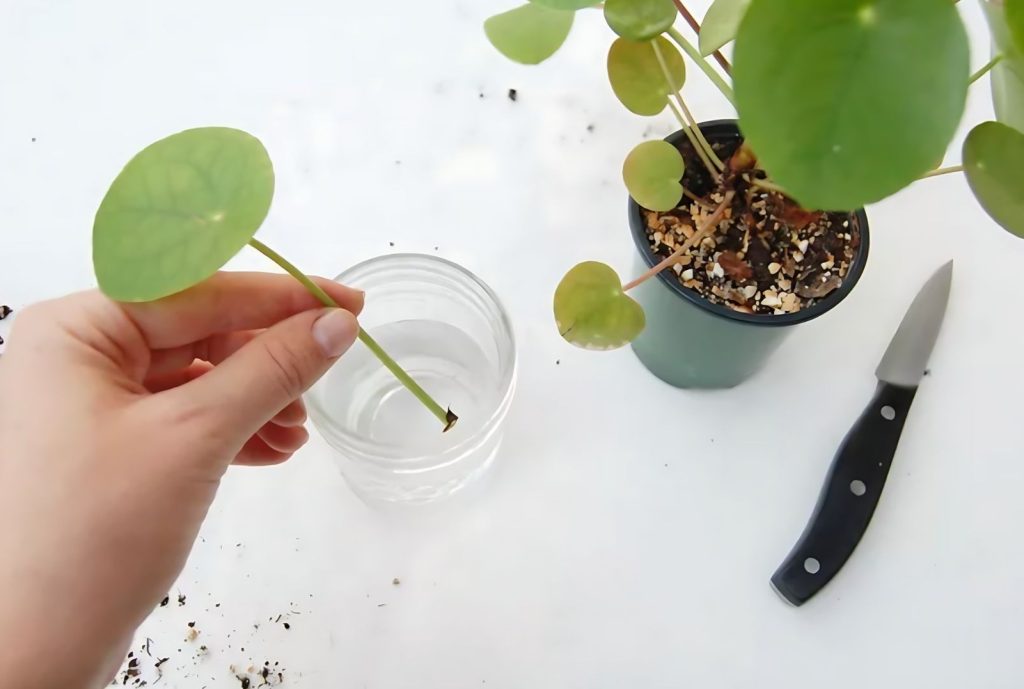
Now, let’s get your cutting to grow roots:
- Fill a small container with clean water.
- Put the cutting in the water so the stem part is under the water, but the leaf stays above it.
- Place the container somewhere that gets bright light but not direct sunlight.
- Change the water once a week to keep it fresh. This helps stop any harmful bacteria from growing.
- Be patient! It usually takes 1-2 weeks for roots to start growing.
Step 3: Planting in Soil After Roots Grow
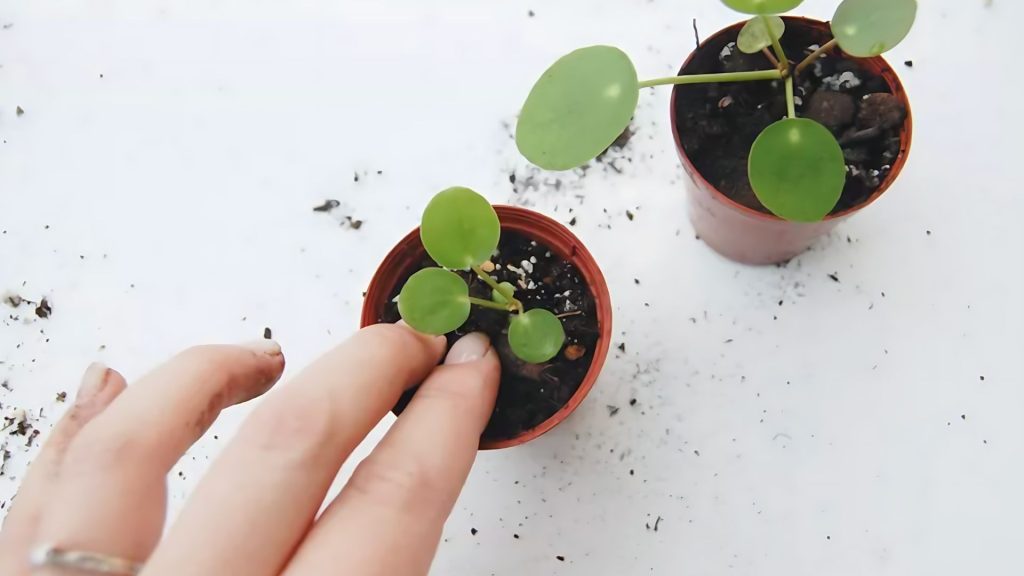
Once your cutting has roots about an inch long, it’s time to plant it:
- Get a small pot and fill it with soil that drains well. Adding some perlite to the soil can help with drainage.
- Make a small hole in the soil.
- Gently place your rooted cutting into the hole.
- Press the soil around the roots to help the plant stand up straight.
- Water the plant well.
- Put your new plant in a spot with bright light but not direct sun.
- For the first couple of weeks, keep the soil a bit damp. This helps your new plant get used to being in soil.
Following these steps, you can grow new Pilea plants, even from a young plant. It takes more time and care than dividing, but it’s a fun way to expand your plant collection.
Pilea Peperomioides (Chinese Money Plant): Basic Care Guidelines
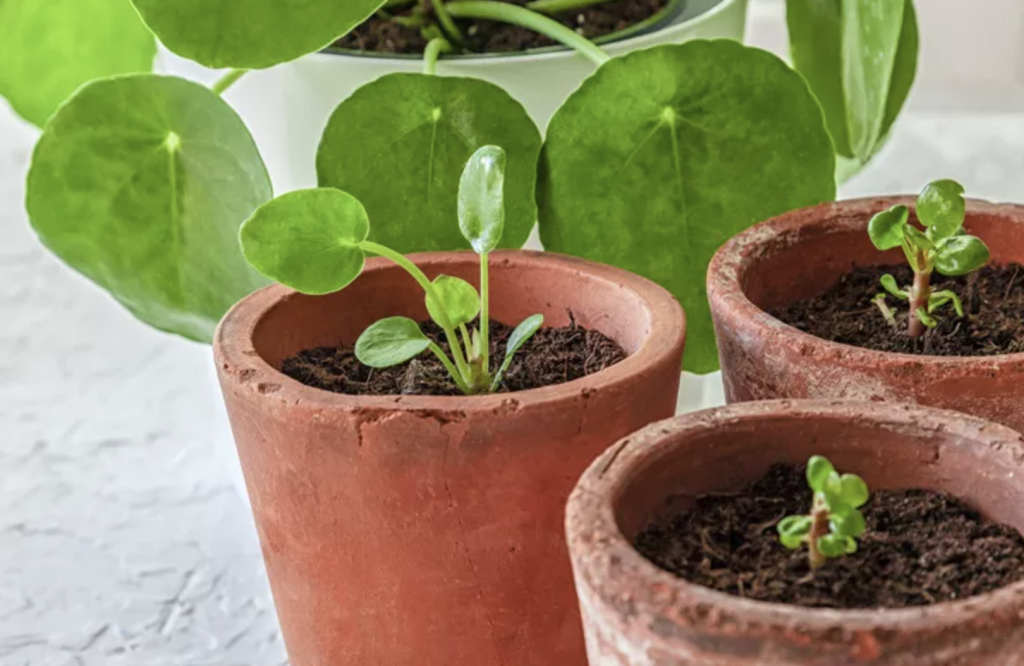
1. Light Requirements
Medium to Bright Indirect Light
Pilea peperomioides plants do best in medium to bright indirect light. This means they need a spot that’s well-lit but not in the direct path of the sun’s rays.
If you put your Chinese money plant in direct sunlight, its leaves might get burned. On the other hand, if there’s not enough light, the plant could grow long and thin.
To give your Pilea the right amount of light, put it near a bright window but not right in it.
If you only have a spot with direct sunlight, you can use thin curtains to soften the light and protect your plant.
Regular Rotation for Even Growth
It’s a good idea to turn your Pilea peperomioides regularly. This helps make sure all parts of the plant get equal light.
Without turning, your plant might lean towards the light source, making it grow unevenly.
To keep your Chinese money plant growing evenly, try turning it about a quarter turn every few days. This simple step can help your plant stay healthy and look its best.
How Light Affects Plant Health
The amount of light your Pilea gets can change how it grows.
With the right amount of light, you’ll see bright, lively leaves, and your plant will likely produce more little plants (called offshoots) around its base.
If your Pilea doesn’t get enough light, it might grow tall and thin, and its leaves could get smaller. But with bright, indirect light, your plant will likely grow fuller and healthier with more offshoots.
Just be careful not to give it too much light—if the leaves start to look burned or fade in color, that’s a sign they’re getting too much sun.
2. Soil and Potting
Soil that drains well is very important for Pilea peperomioides. This type of soil lets water flow through quickly, which helps prevent the roots from sitting in water and rotting.
When you pot your Chinese money plant, use a pot with holes in the bottom. These holes let extra water drain out. Avoid heavy soils holding too much water, which can harm your plant.
For your Pilea, pick a high-quality potting mix that drains well. A mix made with peat or coir (coconut fiber) works great, especially if you add some perlite.
When Choosing Soil:
- Look for an organic potting mix made for indoor plants.
- To help with drainage, you can mix in some perlite or sand.
- Add a small amount of compost to give your plant extra food.
- The soil should have a pH between 6.0 and 7.0. This range is just right for your Pilea to grow its best.
3. Watering Schedule
How Often to Water
For Pilea peperomioides, it’s best to water when the top 1-2 inches of soil feel dry. This method helps keep your plant healthy without giving it too much water.
To check if your Chinese money plant needs water, stick your finger in the soil. If it feels dry, it’s time to water. When you do water, do it thoroughly until you see water coming out of the pot’s bottom holes.
Remember, your plant needs less water in cooler months when it’s not growing as much.
Signs of Too Much or Too Little Water
Knowing if you’re giving your Pilea too much or too little water can help you take better care of it.
If your plant isn’t getting enough water, its leaves will start to sag. They might also curl or turn brown at the edges.
Conversely, if you water too much, the leaves might turn yellow. The plant could also get root rot, which is bad for its health.
Remember that your plant’s water needs can change based on humidity or warmth. Using soil that drains well and pots with holes in the bottom can help prevent water from building up too much.
4. Temperature and Humidity
Best Temperature Range
Pilea peperomioides grows best in temperatures between 50°F and 85°F (10°C to 30°C), which is the range most homes use, which is good news for indoor gardeners.
Avoid putting your Chinese money plant near drafty windows, heating vents, or air conditioners. These spots can experience sudden temperature changes that are harmful to your plant.
While short periods of cooler temperatures can help your Pilea bloom, don’t let it stay below 50°F (10°C) for too long.
Humidity Needs and How to Provide Them
Pilea peperomioides likes moderate humidity. The good news is that the moisture in most homes is usually fine for this plant. However, if the air gets very dry, it can stress your plant.
If you think your plant needs more humidity, here are some things you can do:
- Put a tray filled with pebbles and water under your plant’s pot. As the water evaporates, the air around your plant becomes more humid.
- Use a humidifier near your plant.
- Group your plants together. This can create a small area with higher humidity.
- Try to keep your Pilea away from heating vents, as these can make the air very dry.
5. Fertilizing
When to Fertilize
It’s a good idea to feed your Pilea peperomioides once a month during spring and summer. This is when the plant is growing the most and needs extra nutrients.
The plant grows more slowly in fall and winter, so you can reduce fertilizing or stop altogether during these months.
What Fertilizer to Use and How to Apply It
For your Chinese money plant, use a balanced, all-purpose fertilizer. Look for one with equal parts of the main nutrients, like 10-10-10 or 20-20-20.
Liquid fertilizers work well because they spread evenly in the soil. To avoid giving your plant too much fertilizer, mix it to half the strength the package suggests.
Here Are Some Tips for Fertilizing:
- Always apply fertilizer to damp soil to prevent hurting the roots.
- If you prefer a more natural approach, you can use organic fertilizers.
- Follow the instructions on the fertilizer package for how much to use.
The Final Word
Caring for a Pilea peperomioides isn’t just about keeping a plant alive—it’s about nurturing a living piece of nature in your home.
By following these guidelines for light, soil, water, and propagation, you’re not just growing a plant but cultivating a skill and potentially starting a new hobby.
Remember, every plant is unique. Pay attention to how your Chinese money plant responds to your care, and adjust as needed.
Don’t be discouraged if your first attempts at propagation don’t succeed—it’s all part of the learning process.
Now that you’re equipped with this knowledge, why not try it? Start with one Pilea; before you know it, you might have a family of these charming plants.
Happy Growing!






